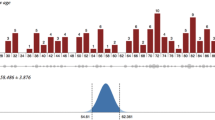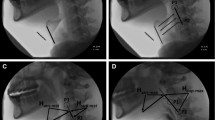Abstract
Cross-sectional imaging has long been employed to examine swallowing in both the sagittal and axial planes. However, data regarding temporal swallow measures in the upright and supine positions are sparse, and none have employed the MBS impairment profile (MBSImP). We report temporal swallow measures, physiologic variables, and swallow safety of upright and supine swallowing in healthy subjects using videofluoroscopy (VFS). Twenty healthy subjects ages 21–40 underwent VFS study upright and supine. Subjects were viewed in the sagittal plane and swallowed 5 mL liquid and pudding barium. Oral transit time, pharyngeal delay time, pharyngeal response time, pharyngeal transit time, and total swallow duration were measured. Penetration/aspiration scores and 14 MBSImP variables were analyzed in both positions. All subjects completed swallows supine, although one aspirated on one liquid bolus. Temporal measures of swallowing were similar for pudding upright and supine. Pharyngeal phase swallow measures were longer for liquids in supine. MBSImP physiologic measures revealed a pharyngeal delay in both positions. Although Pen/Asp range was higher supine, more subjects penetrated upright. Temporal measures were increased for liquids in supine. Although Pen/Asp range was higher in supine, more subjects penetrated upright. These results provide support for cross-sectional supine imaging of swallowing for pudding, but perhaps not thin liquids for dysphagic patients. Slightly thicker liquids might prove reliable in supine without compromising swallow safety. Future research should examine swallow physiology in both positions in dysphagic and older healthy subjects.


Similar content being viewed by others
References
Palmer JB, Tanaka E, Siebens AA. Motions of the posterior pharyngeal wall in swallowing. Laryngoscope. 1988;98(4):414–7.
Kahrilas PJ, Logemann JA, Lin S, Ergun GA. Pharyngeal clearance during swallowing: a combined manometric and videofluoroscopic study. Gastroenterology. 1992;103(1):128–36.
Dejaeger E, Pelemans W, Ponette E, Joosten E. Mechanisms involved in post deglutition retention in the elderly. Dysphagia. 1997;12(2):63–7.
Ergun GA, Kahrilas PJ, Lin S, Logemann JA, Harig JM. Shape, volume, and content of the deglutitive pharyngeal chamber imaged by ultrafast computerized tomography. Gastroenterology. 1993;105(5):1396–403.
Pouderoux P, Kahrilas PJ. Deglutitive tongue force modulation by volition, volume, and viscosity in humans. Gastroenterology. 1995;108(5):1418–26.
Robbins J, Gangnon RE, Theis SM, Kays SA, Hewitt AL, Hind JA. The effects of lingual exercise on swallowing in older adults. J Am Geriatr Soc. 2005;53(9):1483–9.
Ekberg O, Nylander G. Pharyngeal dysfunction after treatment for pharyngeal cancer with surgery and radiotherapy. Gastrointest Radiol. 1983;8(2):97–104.
Robbins J, Kays SA, Gangnon RE, et al. The effects of lingual exercise in stroke patients with dysphagia. Arch Phys Med Rehabil. 2007;88(2):150–8.
Sonies BC, Parent LJ, Morrish K, Baum BJ. Durational aspects of the oral-pharyngeal phase of swallow in normal adults. Dysphagia. 1988;3(1):1–10.
Miller JL, Watkin KL. Lateral pharyngeal wall motion during swallowing using real time ultrasound. Dysphagia. 1997;12(3):125–32.
Takehara I, Chu J. Pharynx and oesophagus evaluation during the swallow using helical computerized tomography. Disabil Rehabil. 2004;26(12):733–8.
Pouderoux P, Ergun GA, Lin S, Kahrilas PJ. Esophageal bolus transit imaged by ultrafast computerized tomography. Gastroenterology. 1996;110(5):1422–8.
Inamoto Y, Fujii N, Saitoh E, et al. Evaluation of swallowing using 320-detector-row multislice CT. Part II: kinematic analysis of laryngeal closure during normal swallowing. Dysphagia. 2011;26(3):209–17.
Fujii N, Inamoto Y, Saitoh E, et al. Evaluation of swallowing using 320-detector-row multislice CT. Part I: single- and multiphase volume scanning for three-dimensional morphological and kinematic analysis. Dysphagia. 2011;26(2):99–107.
Amin MR, Achlatis S, Lazarus CL, et al. Dynamic magnetic resonance imaging of the pharynx during deglutition. Ann Otol Rhinol Laryngol. 2013;122(3):145.
Amin MR, Lazarus CL, Pai VM, et al. 3 Tesla turbo-FLASH magnetic resonance imaging of deglutition. Laryngoscope. 2012;122(4):860–4.
Lafer M, Achlatis S, Lazarus C, Fang Y, Branski RC, Amin MR. Temporal measurements of deglutition in dynamic magnetic resonance imaging versus videofluoroscopy. Ann Otol Rhinol Laryngol. 2013;122(12):748–53.
Fritz M, Cerrati E, Fang Y, et al. Magnetic resonance imaging of the effortful swallow. Ann Otol Rhinol Laryngol. 2014;123(11):786–90.
Martin-Harris B, Brodsky MB, Michel Y, et al. MBS measurement tool for swallow impairment–MBSImp: establishing a standard. Dysphagia. 2008;23(4):392–405.
Lazarus CL, Logemann JA, Rademaker AW, et al. Effects of bolus volume, viscosity, and repeated swallows in nonstroke subjects and stroke patients. Arch Phys Med Rehabil. 1993;74(10):1066–70.
Logemann JA, Pauloski BR, Colangelo L, Lazarus C, Fujiu M, Kahrilas PJ. Effects of a sour bolus on oropharyngeal swallowing measures in patients with neurogenic dysphagia. J Speech Hear Res. 1995;38(3):556–63.
Bisch EM, Logemann JA, Rademaker AW, Kahrilas PJ, Lazarus CL. Pharyngeal effects of bolus volume, viscosity, and temperature in patients with dysphagia resulting from neurologic impairment and in normal subjects. J Speech Hear Res. 1994;37(5):1041–59.
Rosenbek JC, Robbins JA, Roecker EB, Coyle JL, Wood JL. A penetration-aspiration scale. Dysphagia. 1996;11(2):93–8.
Malandraki GA, Sutton BP, Perlman AL, Karampinos DC, Conway C. Neural activation of swallowing and swallowing-related tasks in healthy young adults: an attempt to separate the components of deglutition. Hum Brain Mapp. 2009;30(10):3209–26.
Humbert IA, Fitzgerald ME, McLaren DG, et al. Neurophysiology of swallowing: effects of age and bolus type. Neuroimage. 2009;44(3):982–91.
Dejaeger E, Pelemans W, Ponette E, Vantrappen G. Effect of body position on deglutition. Dig Dis Sci. 1994;39(4):762–5.
Johnsson F, Shaw D, Gabb M, Dent J, Cook I. Influence of gravity and body position on normal oropharyngeal swallowing. Am J Physiol. 1995;269(5 Pt 1):G653–8.
Barkmeier JM, Bielamowicz S, Takeda N, Ludlow CL. Laryngeal activity during upright vs. supine swallowing. J Appl Physiol (1985). 2002;93(2):740–5.
Borgstrom PS, Ekberg O. Peristalsis in pharyngeal constrictor musculature in relation to positioning and gravity. Acta Radiol. 1989;30(2):183–5.
Inagaki D, Miyaoka Y, Ashida I, Ueda K, Yamada Y. Influences of body posture on duration of oral swallowing in normal young adults. J Oral Rehabil. 2007;34(6):414–21.
Perry JL, Bae Y, Kuehn DP. Effect of posture on deglutitive biomechanics in healthy individuals. Dysphagia. 2012;27(1):70–80.
Dodds WJ, Taylor AJ, Stewart ET, Kern MK, Logemann JA, Cook IJ. Tipper and dipper types of oral swallows. AJR Am J Roentgenol. 1989;153(6):1197–9.
Hutcheson KA, Lewin JS, Barringer DA, et al. Late dysphagia after radiotherapy-based treatment of head and neck cancer. Cancer. 2012;118(23):5793–9.
Gullung JL, Hill EG, Castell DO, Martin-Harris B. Oropharyngeal and esophageal swallowing impairments: their association and the predictive value of the modified barium swallow impairment profile and combined multichannel intraluminal impedance-esophageal manometry. Ann Otol Rhinol Laryngol. 2012;121(11):738–45.
Author information
Authors and Affiliations
Corresponding author
Rights and permissions
About this article
Cite this article
Su, H.K., Khorsandi, A., Silberzweig, J. et al. Temporal and Physiologic Measurements of Deglutition in the Upright and Supine Position with Videofluoroscopy (VFS) in Healthy Subjects. Dysphagia 30, 438–444 (2015). https://doi.org/10.1007/s00455-015-9620-7
Received:
Accepted:
Published:
Issue Date:
DOI: https://doi.org/10.1007/s00455-015-9620-7




